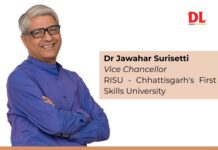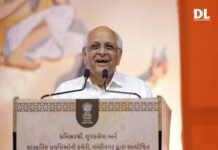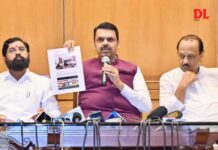
|
May-2007
|
||
|
The government of India feels the country was still a long way from realising the goal of every child completing eight years of good quality education. Human Resource Development Minister Arjun Singh made this admission while convening the two-day conference of state education ministers, to discuss the human resource targets for the Eleventh Five Year Plan. The Minister also admitted that the surveys of the attainment levels of schoolchildren do not give much cause for satisfaction. The Conference of State Education Ministers was organised at New Delhi on 10 and 11 April, 2007, by the Ministry of Human Resources Development that was attended by Education Ministers of 19 of the 28 States. Senior officers of the Education Departments represented the other States and Union Territories. The two Ministers of State in the HRD Ministry, M A A Fatmi and D. Purandeswari, and Bhalchandra Mungekar, Member (Education), Planning Commission, also participated in the Conference. The conference deliberated on issues concerning the entire gamut of education such as elementary, secondary, higher and technical education, to jointly take stock and to plan ahead, so that maximum possible progress can be achieved during the Eleventh Plan in the education sector, in terms of access, equity, quality and efficiency. The minister also hoped that during the Eleventh Plan, the gross enrollment ratio for higher and technical education would go up from the existing figure of 10 percent of the total population of school-going children to at least 15 percent by the end of the plan period.
Points of consensus emerged • The HRD Ministry and State Education Departments will work intensively with other concerned authorities and departments at the Central and State levels, so as to increase public expenditure on education to the level of 6% of GDP, by the end of the XI Plan.
• A consensus emerged to continue the implementation of the SSA programme with vigour and commitment, and with the fullest attention to equity issues; improvement of learning outcomes of students; implementing focused programmes for improving language and mathematics basic levels in early primary grades and tracking student as well as teacher attendance at elementary levels. • The conference endorsed the view that the issue of the Centre-State funding pattern in the SSA to be continued on a 90:10 ratio for the NE States and on a 75:25 ratio for other States be examined appropriately by the Government of India. • The Government of India will re-formulate the parameters of the Mid Day Meal Programme such that the entire upper primary stage is covered by the end of the XI Plan. • With the Universalisation of Elementary Education nearing completion, the imperative of a Scheme for Universalisation of Secondary Education to be implemented in a mission mode was appreciated by all. It was, however, recognised that the contours of the Scheme would only be finalised once the 11th Plan exercise was completed. Pending this, all State Governments and Union Territories were requested to set up a Task Force so as to identify gaps in the secondary education sector, particularly in terms of access and infrastructure. • At least one State University in each State which does not at present have any Central University may be funded to the level of a Central University, through the UGC. • State Governments will also encourage all their universities and colleges to go in for accreditation by NAAC, and in regard to technical education courses by NBA. It was agreed that technical education institutions applying for accreditation to the NBA should not be expected to bear any costs in this regard, except for the prescribed accreditation fees, and that all expenses connected with the inspection visit of the NBA team should be borne by the NBA / AICTE. • Efforts will be made to network all institutions of higher and technical education so that collaborative research and shared experiences strengthen our tertiary education. • State Governments will also advise their universities to adopt / adapt UGC-approved curricula and to switch over to semester and credit systems, within two years. • States agreed to encourage their universities / colleges and technical education institutions to become members of INFLIBNET (Information for Library Network) and INDEST (Indian National Digital Library for Engg. Sciences and Technology) consortia, respectively, so that they gain access to e-Journals and other online academic resources through the centralised subscription process of these consortia. • States may also urgently consider setting up State Councils of Higher Education. According to available information, only Andhra Pradesh, Uttar Pradesh, West Bengal and Tamil Nadu have done this so far. • States whose intake capacity in technical education courses per lakh population is significantly less than the national average, agreed to initiate necessary programmes in the XI Plan so as to come up to the level of the national average. • States agreed to make efforts to set up, by the end of the XI Plan, a polytechnic in each of those Districts which do not have a polytechnic at present, but are large enough to sustain one. The Ministry will work towards providing financial assistance of non-recurring nature for this purpose. • States noted the need to quickly enter into tripartite MoU with ISRO and MHRD for proper utilization of EDUSAT. All states which are yet to execute these MoUs, agreed to do so in the next two months. States which have already executed the MoUs agreed to intensify efforts for providing infrastructural and administrative facilities for installation and maintenance of Satellite Interactive Terminals (SITs) and Receive Only Terminals. |
||







 The discussions revolved round all the vital aspects of education in India. What should we now do to accomplish the goal of Universal Elementary Education (UEE) by the end of the Eleventh Plan? How do we improve achievement levels of children in elementary and secondary schools, especially state funded ones? What action is being taken by states to meet their enhanced share under SSA in the Eleventh Plan? What steps should be taken to increase the Gross Enrollment Ratio for higher and technical education from the present about 10% to at least 15% by the end of the Eleventh Plan? Despite increased outlays, we are still quite far from the goal of spending 6% of GDP on education, which has been reiterated in the Approach paper to the Eleventh Plan. How best can this responsibility be equitably shared between the Centre and the states? How to improve quality of higher education, especially in state-funded colleges and universities? How to maximise use of ICT, including EDUSAT to widen access and improve quality of education at various stages? The discussion also included many other aspects like minority education and vocational education in the country.
The discussions revolved round all the vital aspects of education in India. What should we now do to accomplish the goal of Universal Elementary Education (UEE) by the end of the Eleventh Plan? How do we improve achievement levels of children in elementary and secondary schools, especially state funded ones? What action is being taken by states to meet their enhanced share under SSA in the Eleventh Plan? What steps should be taken to increase the Gross Enrollment Ratio for higher and technical education from the present about 10% to at least 15% by the end of the Eleventh Plan? Despite increased outlays, we are still quite far from the goal of spending 6% of GDP on education, which has been reiterated in the Approach paper to the Eleventh Plan. How best can this responsibility be equitably shared between the Centre and the states? How to improve quality of higher education, especially in state-funded colleges and universities? How to maximise use of ICT, including EDUSAT to widen access and improve quality of education at various stages? The discussion also included many other aspects like minority education and vocational education in the country. States noted the need to quickly enter into tripartite MoU with ISRO and MHRD for proper utilisation of EDUSAT. All states which are yet to execute these MoUs,agreed to do so in the next two months.
States noted the need to quickly enter into tripartite MoU with ISRO and MHRD for proper utilisation of EDUSAT. All states which are yet to execute these MoUs,agreed to do so in the next two months.










